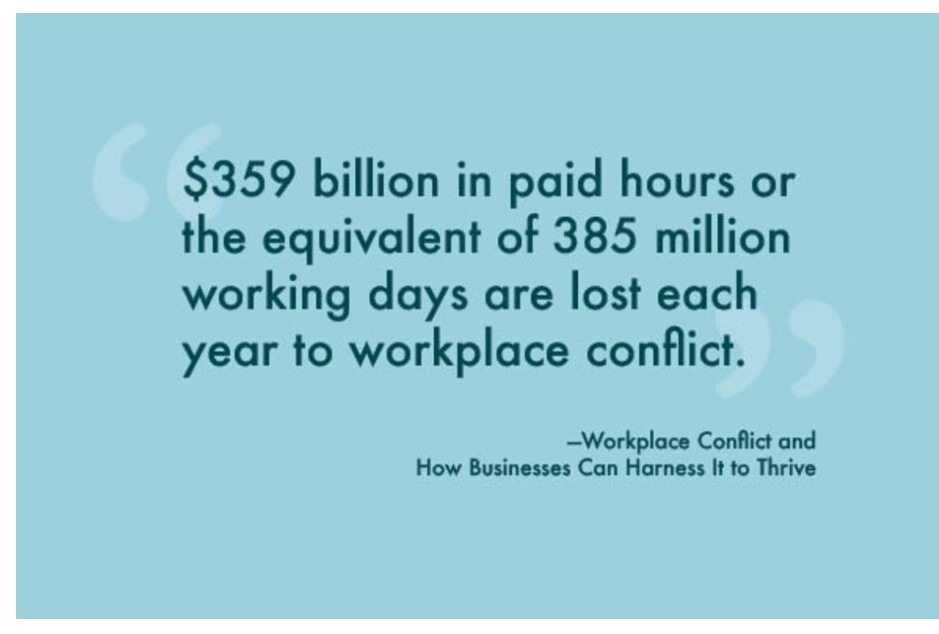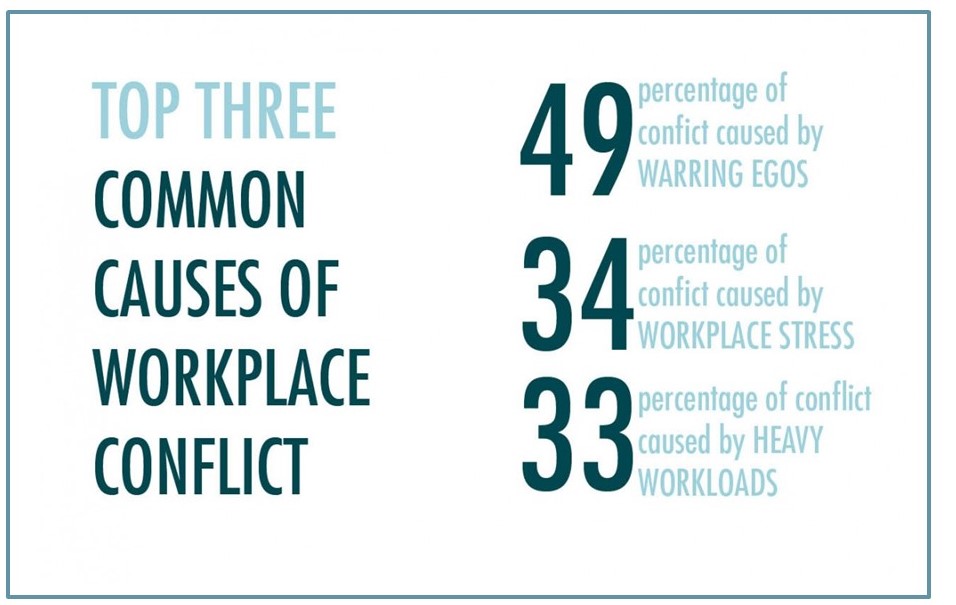Unit 30: Conflict Resolution Strategies
Learning Objectives

After studying this unit, you will be able to
-
-
- rank several types of response to conflict in the workplace in order of most appropriate to least
- explain a collaborative approach to resolving workplace conflict
-
Introduction
A behavioural question job applicants often hear during a job interview is how they would handle a conflict situation with a customer or co-worker. Would you know how to answer it? It’s a good question because conflict certainly happens in the workplace. The potential for conflict exists anywhere two or more motivated people interact. Most people are conflict-averse, but some have no problem aggressively defending their interests, and some even seem to seek out conflict just for the thrill of it. Even though we’re well beyond playground politics, adults can still be bullies in the workplace. Even when two otherwise good people lose themselves in the heat of an argument, knowing how to deal with such situations is a vital workplace skill.

First, it’s worth knowing what conflict is, why it arises, and what it is not. Conflict is the physical or psychological struggle associated with the perception of opposing or incompatible goals, desires, demands, wants, or needs (McLean, 2005). Conflict is universal and typically arises with opposing interests, scarce resources, or interference, but it doesn’t necessarily mean the relationship between parties in conflict is fundamentally broken. All relationships progress through times of conflict and collaboration. How we manage these moments either reinforces or destroys the relationship. Rather than viewing conflict from an entirely negative frame of reference, we should view it as an opportunity for clarification, learning, growth, and even reinforcement of the relationship.
Conflict Resolution
Conflict arises everywhere communication occurs and can be very costly. Effective communicators can predict, anticipate, and formulate strategies to address conflict in order to successfully resolve it. How you choose to approach conflict influences its resolution. Conflict can be cognitive or affective. Cognitive conflict is productive and constructive. As we discussed, during the storming stage of team formation, there is often conflict. However, the conflict is focused on the tasks, responsibilities, and roles and often serves to clarify these variables and create a clearer vision for the team when the conflict is resolved. Affective conflict, however, is destructive. Here, disagreements are about personalities, personal choices, and feelings. This sort of conflict can lead to permanent group division and disharmony.
Five conflict resolution strategies are presented below.

Competitive Style (Win/Lose): a desire to advance one’s own concerns at the expense of the other party and to dominate. People with this style often resort to blaming or seeking a scapegoat rather than assuming responsibility. People with this style will also resort to threats.
Collaboration (Win/Win): desire to make both people happy. People who have this style are other oriented and view conflict as a set of problems to be solved. Collaboration is best used when those involved in the conflict need new, fresh ideas and perhaps a different direction.
Compromise (½ win, ½ lose): Parties meet somewhere in the middle. People who use this style find a solution that meets the needs of all concerned. When people compromise, they don’t get exactly what they want. Each person gives up a bit of what he/she wants. Compromise can bring about quick solutions and reinforces equality.
Accommodate (Lose/Win): Desire to satisfy the other’s concerns over one’s own concerns. Therefore, people with this style will give in to the demand of others to avoid conflict, rejection, or disruption. Typically, people with this management style like to people please.
Avoidant: Party is indifferent to everyone’s concerns including his/her own. Avoidance is a healthy or unhealthy response to conflict depending on its severity. Rising above trivial bickering is wise, whereas ignoring a serious conflict that threatens to pollute the work atmosphere and hinder productivity just contributes to the toxicity.
Knowledge Check
Conflict Management Skills
When conflict is serious enough that it causes a rift within the workplace culture, the kind that pollutes the work atmosphere and threatens irreparable damage, a methodical, collaborative approach to conflict resolution can help lead to an amicable solution.
Let’s examine the conflict management options.
Confront and Problem Solve: The most effective manner of resolving a conflict is to address it directly. First, the true source of the conflict must be identified. The confrontation in this approach is gentle and tactful no combative and abusive. To ensure this strategy works, allow some time to pass between the conflict and problem-solving. An important advantage of this option is its focus on the issue that caused the conflict and not on the personalities involved in the conflict.
Reframing: Looking at a conflict from an alternative point of view helps to shed light on the causes of the conflict. Cognitive restructuring allows you to reframe the conflict and to gain insight into possible solutions. How you frame or choose your thoughts can determine the outcome of a conflict. Seeing the conflict from the other side allows you to also deal with the conflict in a positive way.
Appeal to Third Party: When there seems no path to a resolution, enlist the help of a third party with more power than you or the other parties in the conflict have. In many cases, simply suggesting that a third party will be contacted will encourage all parties to find their own resolution.
Negotiation: Conflicts often involve negotiations. Negotiations require that all parties are open to cooperating and to compromise. Negotiation takes place frequently in the workplace. The achieve the best negotiations: create a positive negotiating environment, practice active listening, be reasonable, focus on common ground, make a last and final offer, be tactful.
Conflicts are inevitable, but conflicts do not have to be dysfunctional. Understanding your conflict management style and possessing some conflict resolution skills will make you more effective in the work environment.
Knowledge Check
Key Takeaway
 Conflict is inevitable in any workplace with human interaction, so responding to it in ways that promote professionalism requires excellent communication skills and conflict-resolution strategies.
Conflict is inevitable in any workplace with human interaction, so responding to it in ways that promote professionalism requires excellent communication skills and conflict-resolution strategies.
Exercises
 1. Write a description of a situation you recall where you came into conflict with someone else. It may be something that happened years ago or a current issue that just arose. Using the principles and strategies in this section, describe how the conflict was resolved or could have been resolved.
1. Write a description of a situation you recall where you came into conflict with someone else. It may be something that happened years ago or a current issue that just arose. Using the principles and strategies in this section, describe how the conflict was resolved or could have been resolved.
2. Can you think of a time when a conflict led to a new opportunity, better understanding, or other positive results? If not, think of a past conflict and imagine a positive outcome. Write a two- to three-paragraph description of what happened, or what you imagine could happen.
References
AccreditedSkills. (2014). How to deal with conflict [Video file]. Youtube. https://www.youtube.com/watch?v=QLbGHQo4qnA
DeVito, J. (2003). Messages: Building interpersonal skills. Boston: Allyn & Bacon.
Donohue, W., & Klot, R. (1992). Managing interpersonal conflict. Thousand Oaks, CA: Sage.
Gibb, J. (1961). Defensive and supportive communication. Journal of Communication, 11, 141–148.
Osgood, C. E. (1962). An alternative to war or surrender. Urbana: University of Illinois Press. Retrieved from https://books.google.ca/books/about/An_alternative_to_war_or_surrender.html?id=gushAAAAMAAJ&redir_esc=y
Psychology. (2016, January 8). GRIT tension reduction strategy. Retrieved from https://psychology.iresearchnet.com/social-psychology/antisocial-behavior/grit-tension-reduction-strategy/
RobynShort.com. (2016). 6 tips for increasing collaboration in the workplace. Retrieved from http://robynshort.com/2016/04/06/six-tips-increasing-collaboration-workplace/
RobynShort.com. (2016). The cost of conflict in the workplace. Retrieved from http://robynshort.com/2016/02/16/the-cost-of-conflict-in-the-workplace/
Mentally converting negative aspects into positive ones by looking for the positive elements in a situation.

